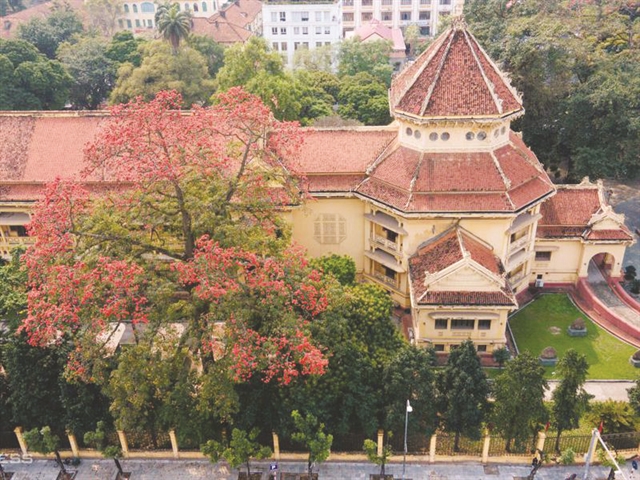HÀ NỘI — Flower lovers are in for a treat at an 'oasis' in downtown Hà Nội.
The National Museum of Vietnamese History and Hanoitourist offer a special daily tour to admire kapok blossom inside the museum’s grounds.
Phùng Quang Thắng, director of Hanoitourist, said tour companies are busy preparing tourism products to be ready for receiving guests now borders are opening.
“The plan for such a tour has been discussed by the company and the museum for a long time as a fresh tourism product, which is special in Hà Nội for visitors,” he said.
Every March, the Museum building, which is of Indochina style, is brightened up with kapok blossom.

A kapok tree is in blossom at the National Museum of Vietnamese History. — Photo hanoitourist.vn
“The tour titled 'Bác Cổ -- Kapok Flower Season' and the existing walking tour are two typical tours in the capital,” he said. Bác Cổ was short, former Vietnamese name of the museum.
The new tour will be sold at 50 per cent reduction price in March, costing just VNĐ25,000 (US$1) per child under 12, and VNĐ 75,000 per adult.
The tour is available with guides between 8.30-10.30am and 1.30-3.30pm every day and last between 60 and 90 minutes.
“Visitors will not only admire the beauty of the flower, take photos but also understand folk culture of the north rural area through folk games, by the old kapok tree,” he said.
Visitors will also have a chance to understand various national treasures preserved at the museum like Ngọc Lũ drum, Vân Bản Pagoda’s bell, stone stale from Tứ Kỳ Pagoda and an ancient stone bridge.
“I hope the tour will meet the demand of visitors, who tend to prefer pristine nature,” Thắng said.
To buy the tour, please visit tourticket.vn or call 090 4 886 561 or 091 4 380 069. The museum is located at 1 Tràng Tiền Street.

Women like to take photos with the kapok flowers. — Photo hanoitourist.vn
Kapok trees are in full bloom in March for few weeks only. The flowers with five large bright red petals are mostly seen in the north of the country.
Big old kapok trees, ancient water wells and communal houses are common features of the northern rural villages. The tree is called "Pơ Lang" in the Central Highlands region.
The flowers stay beautiful for a few weeks before falling when summer comes. Then the young buds of leaves will appear on bare branches. — VNS
OVietnam